63 HOME INSTRUCTIONS
Lateral Tilt Over Roll
Purpose
To develop head and trunk balance reactions in sitting position
Instructions
1. Place child sitting on a roll. Support by holding child by arms as pictured in Figure 1.
2. Slowly tilt child to one side. When child begins to respond by turning head, assist the child to an upright position. Repeat in opposite direction (see Figures 2 and 3).
Desired Response
Head will remain erect.
Undesired Response
Head will flop over in direction of tilt. Back, neck, or shoulders will become stiff.
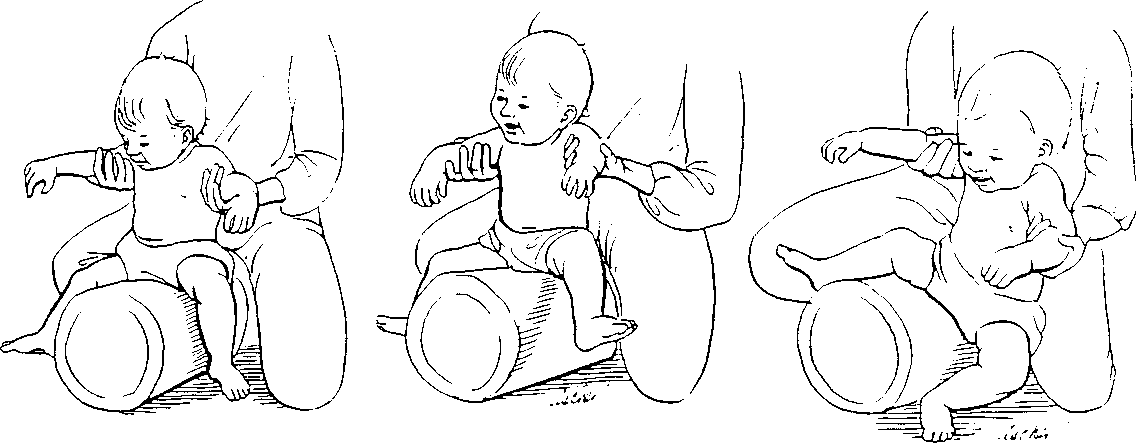
64 HOME INSTRUCTIONS
Rotation to Hand Support Over Roll
Purpose
To increase trunk relaxation, improve balance reactions, and enable child to bear weight on hands.
Instructions
1. Place child in sitting position over a roll. Support child by placing one of your hands on child's chest. Place your other hand on child's leg (see Figure 1). Note: If you are going to tilt child to the right, place your right hand on chest, left hand on leg.
2. Slowly tilt child sideways while turning the trunk toward side of tilt. Arms should be forward (see Figures 2 and 3).
3. Continue to tilt and rotate downward until child is supporting weight on hands. Elbows should be straight and hands open. The leg you are holding should be straight (see Figure 4).
Desired Response
Child will assist in going from sitting position to bearing weight on extended arms. Child will assist in returning to sitting position.
Undesired Response
1. Child will hyperextend neck, back, or shoulders.
2. Child will collapse to side of tilt.
3. Arms will become stiff, either rigidly extended or bent with hands fisted.
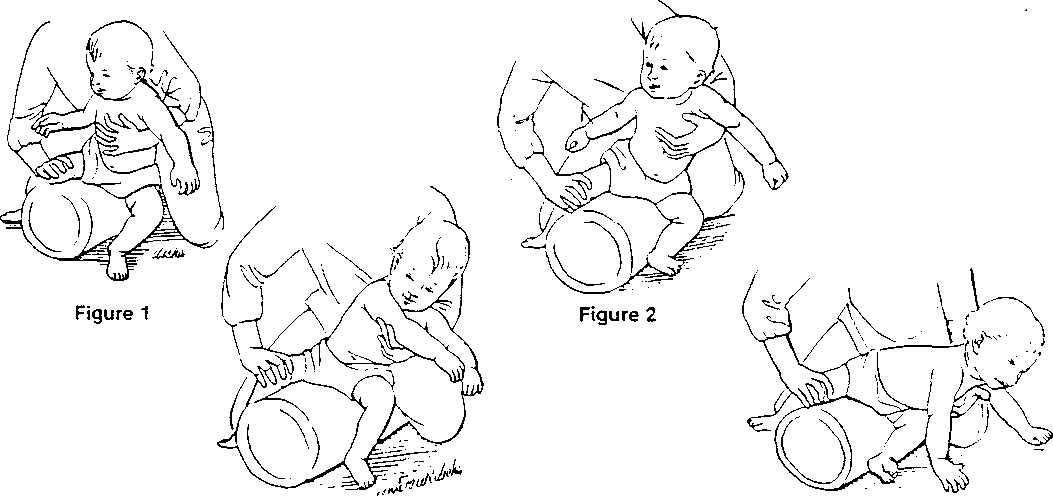
65 HOME INSTRUCTIONS
Tilting on Roll Forward and Back (for Trunk)
Purpose
To develop trunk control
Instructions
1. Place child on roll in front of you.
2. Support at the hips or thighs as needed (see Figure 1).
3. Tilt child forward (see Figure 2).
4. Tilt child backward (see Figure 3).
Desired Response
1. Child will straighten back but tuck chin when tilted forward.
2. Child will bend forward when tilted backward.
Undesired Response
1. Child will arch back.
2. Child will collapse forward when tilted.
3. Child will lose balance.
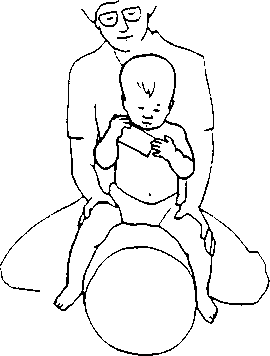
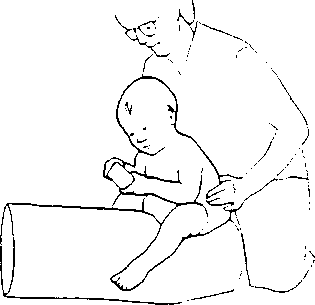
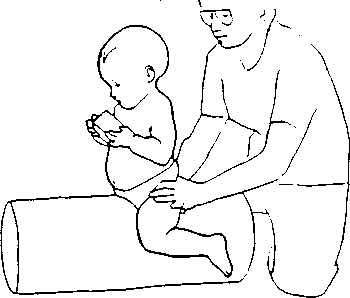
66 HOME INSTRUCTIONS
Tilting on Roll Sideways (for Trunk)
Instructions
1. Place child on roll in front of you.
2. Support at the hips or thighs as needed (see Figure 1).
3. Tilt sideways (see Figures 2 and 3).
Desired Response
1. Child will curve trunk.
2. Child will maintain head upright.
Undesired Response
1. Child will lose balance.
2. Child will hold on to roll with hands and will not use trunk.
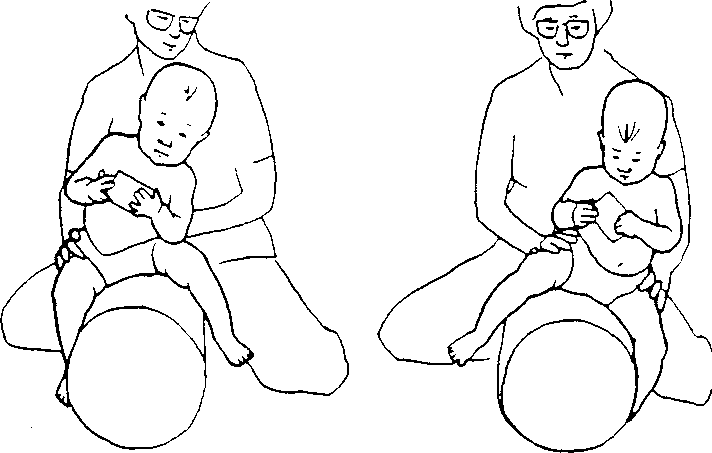
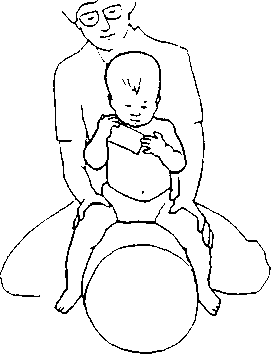
67 HOME INSTRUCTIONS
Playing Forward on Roll
Purpose
To help child learn to keep back straight while bending at hips
Instructions
1. Place child straddling a bolster with feet flat on the floor.
2. Support at hips if needed (see Figure 1).
3. Provide toys in front of child for play.
4. Encourage child to lean forward to play and return to sitting (see Figure 2).
Desired Response
Child will be able to maintain trunk stability and movement while playing.
Undesired Response
Child will bend trunk and not at the hips.
Special Instructions
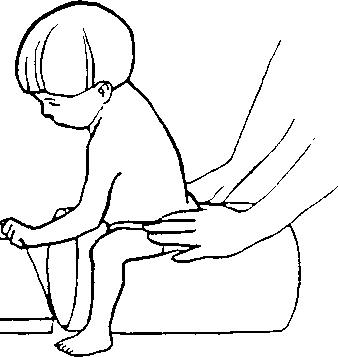
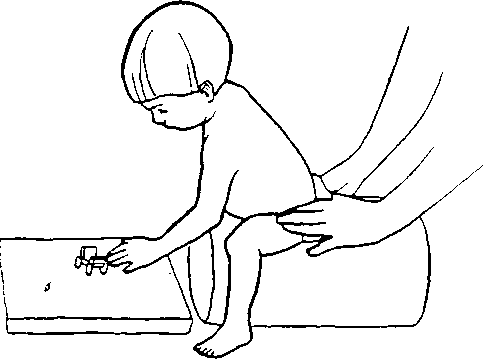
68 HOME INSTRUCTIONS
Reaching Sideways on Roll
Purpose
To encourage weight shift and reaching
Instructions
1. Place child straddling a roll, support the hips or lower trunk as needed.
2. Have child reach up and to the side for a favorite toy just beyond child's ability to grasp. Then allow child to get the toy (see Figure 1).
3. Repeat on opposite side (Figure 2).
Desired Response
Child will shift weight to the side and rotate the trunk.
Undesired Response
1. The child will become stiff.
2. The arms may bend at the elbow and shoulders pull back.
3. The child will fall in the direction of the toy.
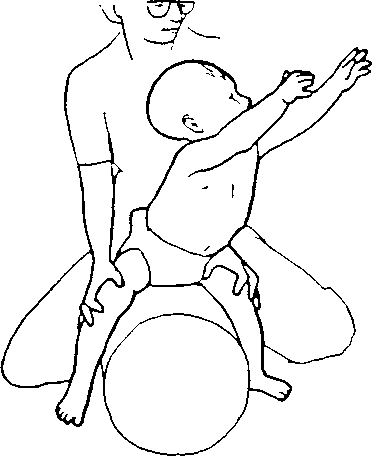
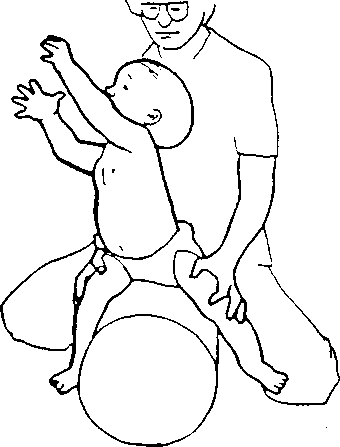
69 HOME INSTRUCTIONS
Side-Sit Prone Over Roll
Purpose
To encourage isolated head control
Desired Response
1. Place child in side-sitting position next to roll.
2. Support the child's legs with one hand and support the arm and shoulders with the other.
3. Gently bring the upper trunk over the roll.
Desired Response
Child will maintain head control.
Undesired Response
1. Body will become stiff.
2. Child will arch head back.
3. Child's head will flop forward.
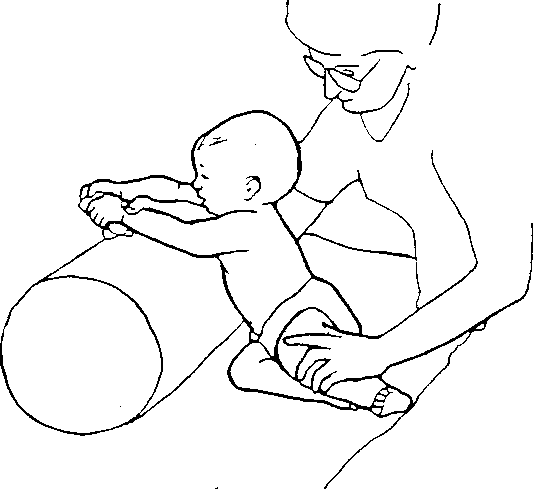
70 HOME INSTRUCTIONS
Sitting on a Ball
Purpose
To improve head and trunk control in a sitting position
Instructions
1. Place child in a sitting position on a ball.
2. Support child by placing your hands under the arms as pictured in Figure 1.
3. Slowly and gently tilt child backwards and to the side (see Figure 2).
4. Encourage child to pull head and body forward. You may do this by holding a favorite toy a short distance away (see Figure 2).
5. Give child plenty of time to respond to the tilt.
Desired Response
Child's head will turn and tilt forward. Child may reach for toy.
Undesired Response
Child's head will flop backward or to the side.
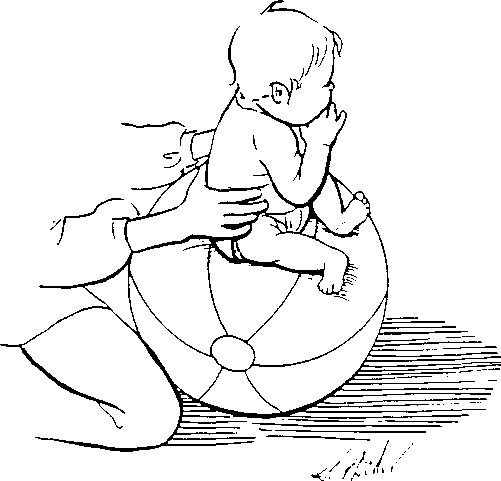
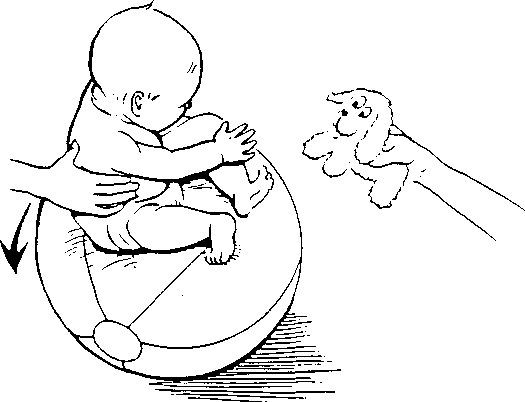
71 HOME INSTRUCTIONS
Tilting on Ball Forward for Trunk (Control from Behind)
Purpose
To encourage straightening of the trunk with tucking of the head
Instructions
1. Place child sitting on a ball.
2. Support at the hips or lower trunk (see Figure 1).
3. Gently and slowly roll the ball forward (see Figure 2).
Desired Response
Child will straighten the trunk and tuck chin.
Undesired Response
Child will become stiff and arch backward.
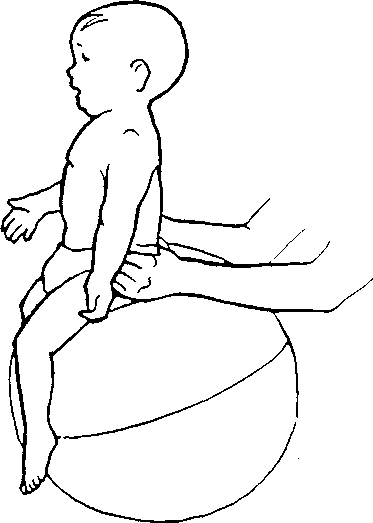
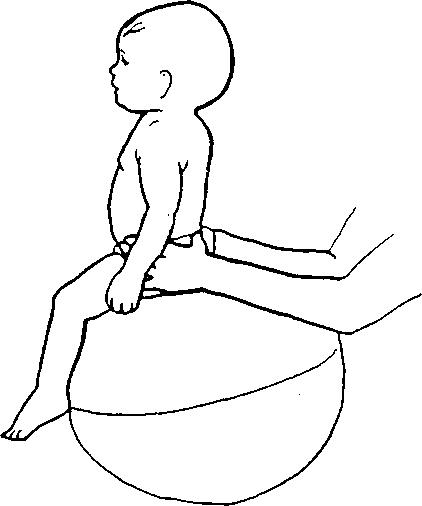
72 HOME INSTRUCTIONS
Tilting on Ball Sideways and Back for Trunk (Control from Behind)
Purpose
To develop trank control
Instructions
1. Place child sitting on a ban.
2. Support child by holding at the hips.
3. Gently and slowly roll the ball to the side and wait for a response (Figure 1).
4. Gently and slowly roll the ball backwards and wait for a response (Figure 2).
Desired Response
1. The trunk will adjust as the support is shifted.
2. The child wiII maintain head in an upright position.
Undesired Response
1. Child will sit toward the side or slump forward.
2. Child will ch backward and become stiff.
3. Child will usearms for support.

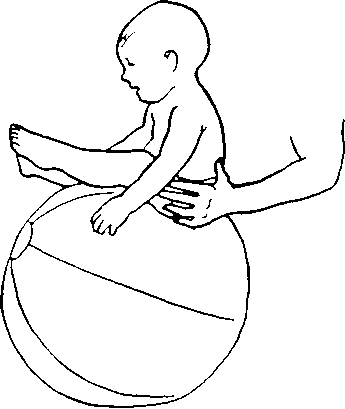
73 HOME INSTRUCTIONS
Tilting on Ball for Trunk (Control from Front)
Purpose
To encourage trunk control in response to tilting
Instructions
1. Place child sitting on ball.
2. Support the child by holding the upper legs and knees firmly with the legs apart and rotated outward (see Figure 1).
3. Gently and slowly roll the ball back (see Figure 2).
4. Gently and slowly roll the ball sideways (see Figure 3).
5. Gently and slowly roll the ball forward (see Figure 4).
Desired Response
The child will maintain the sitting position.
Undesired Response
1. Child will arch back. Note: Be prepared to quickly roll the ball forward if the child loses balance backwards.
2. Child will support with the hands and not use trunk movements.
